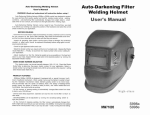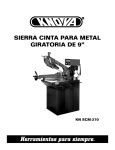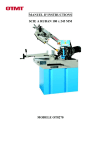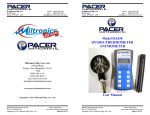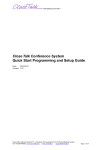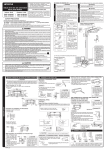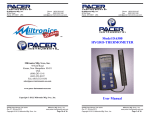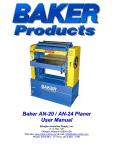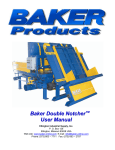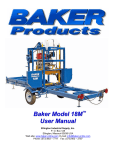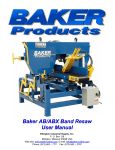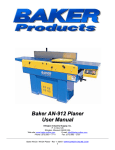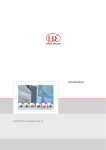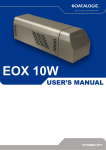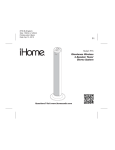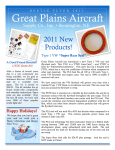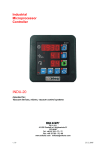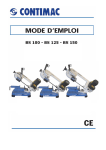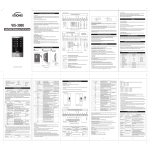Download RF270S - Industrial Tool and Machinery Sales
Transcript
METAL CUTTING BAND SAW MACHINE MODEL: 270S INSTRUCTION MANUAL 050110-R0 Table Of Contents Page No 1 Overall Aspect ………………………………………………………………… 2 Safety Rules For All Tools …………………………………………………… 3 Specification …………………………………………………………………… 4 Features ……………………………………………………………………..… 5 Transportation & Install …………………………………………………….. 6 Minimum Room Space For Machine Operation …………………………… 7 Make Proper Tooth Selection ……………………………………………….. 8 BI-Metal Speeds And Feeds …………………………………………………. 9 Use Of Main Machine Parts …………………………………………………. 10 Maintaining …………………………………………………………………… 11.Trouble shooting ……………………………………………………………… 12 Circuit Diagram ………………………………………………………………. 13 Parts Lists & Drawing ……………………………………………………… CAUTION Install saw blade and blade guard before use. Set proper blade tension to prevent any danger caused by damaged saw blade or work piece. 1 2 3 4 5 5 6 7 7 9 11 11 14 15 1.Overall Aspect The start button The blade tension handle Saw arm Control Panel Motor The vise fixed handle The move vise handle Angle Sale Move Vise Coolant pump Fixed plate Vise base The swivel vise base of handle Base 2 WARNING: FAILURE TO FOLLOW THESE RULES MAY RESULT IN SERIOUS PERSONAL INJURY As with all machinery there are certain hazards involved with operation and use of the machine. Using the machine with respect and caution will considerably lessen the possibility of personal injury. However, if normal safety precautions are overlooked or ignored, personal injury to the operator may result. This machine was designed for certain applications only. We strongly recommend that this machine NOT be modified and/or used for any application other than for which it was designed. If you have any questions relative to its application DO NOT use the machine until you contact with us and we have advised you. Your machine might not come with a power socket or plug. Before using this machine, please do ask your local dealer to install the socket or plug on the power cable end. 2.SAFETY RULES FOR ALL TOOLS A. USER: (1). WEAR PROPER APPAREL. No loose clothing, gloves, rings, bracelets, or other jewelry to get caught in moving parts. Non-slip footwear is recommended. Wear protective hair covering to contain long hair. (2). ALWAYS WEAR EYE PROTECTION. Refer to ANSLZ87.1 standard for appropriate recommendations. Also use face or dust mask if cutting operation is dusty. (3). DON'T OVERREACH. Keep proper footing and balance at all times. (4). NEVER STAND ON TOOL. Serious injury could occur if the tool is tipped or if the cutting tool is accidentally contacted. (5). NEVER LEAVE TOOL RUNNING UNATTENDED. TURN POWER OFF. Don't leave tool until it comes to a complete stop. (6). DRUGS, ALCOHOL, MEDICATION. Do not operate tool while under the influence of drug, alcohol or any medication. (7). MAKE SURE TOOL IS DISCONNECTED FROM POWER SUPPLY. While motor is being mounted, connected or reconnected. (8). ALWAYS keep hands and fingers away from the blade. (9). STOP the machine before removing chips. (10). SHUT- OFF power and clean the BAND SAW and work area before leaving the machine. (11).DO NOT Touch the cutting Blade while the machine is turm on. B. USE OF MACHINE: (1). REMOVE ADJUSTING KEYS AND WRENCHES. Form habit of checking to see that keys and adjusting wrenches are removed from tool before turning it "on". (2). DON'T FORCE TOOL. It will do the job better and be safer at the rate for which it was designed. (3). USE RIGHT TOOL. Don't force tool or attachment to do a job for which it was not designed. (4). SECURE WORK. Use clamps or a vise to hold work when practical. It's safer than using your hand frees both hands to operate tool. (5). MAINTAIN TOOLS IN TOP CONDITION. Keep tools sharp and clean for best and safest performance. Follow instructions for lubricating and changing accessories. (6). USE RECOMMENDED ACCESSORIES. Consult the owner's manual for recommended accessories. The use of improper accessories may cause hazards. (7). AVOID ACCIDENTAL STARTING. Make sure switch is in “OFF” position before plugging in power cord. (8). DIRECTIONOF FEED. Feed work into a blade or cutter against the direction of rotation of the blade or cutter only. (9). ADJUST AND POSITION the blade guide arm before starting the cut. (10). KEEP BLADE GUIDE ARM TIGHT, A loose blade guide arm will affect sawing accuracy. (11). MAKE SURE blade speed is set correctly for material being cut. (12). CHECK for proper blade size and type. (13). STOP the machine before putting material in the vise. (14). ALWAYS have stock firmly clamped in vise before starting cut. (15). GROUNDALL TOOLS. If tool is equipped with three-prong plug, it should be plugged into a three-hole electrical receptacle. If an adapter is used to accommodate atwoprong receptacle, the adapter lug must be attached to a known ground. Never removed the third prong. 3 C. ADJUSTMENT : MAKE all adjustments with the power off. In order to obtain the machine. precision and correct ways of adjustment while assembling, the user should read the detailed instruction in this manual. D. WORKING ENVIRONMENT: (1). KEEP WORK AREA CLEAN. Cluttered areas and benches invite accidents. (2). DON'T USE IN DANGEROUS ENVIRONMENT. Don't use power tools in damp or wet locations, or expose them to rain. Keep work area well-lighted. (3). KEEP CHILEREN AND VISITIORS AWAY. All children and visitors should be kept a safe distance from work area. (4). DON’T install & use this machine in explosive, dangerous environment. E. MAINTENANCE: (1). DISCONNECT machine from power source when making repairs. (2). CHECK DAMAGED PARTS. Before further using of the tool, a guard or other part that is damaged should be carefully checked to ensure that it will operate properly and perform its intended function. Check for alignment of moving parts, binding of moving parts, breakage of parts, mounting, and any other conditions that may affect its operation. A guard or other part that is damaged should be properly repaired or replaced. (3). DISCONNECT TOOLS before servicing and when changing accessories such as blades, bits, cutters, etc. (4). MAKE SURE that blade tension and blade tacking are properly adjusted. (5). RE-CHECK blade tension after initial cut with a new blade. (6). TO RPOLONG BLADE LIFE ALWAYS release blade tension at the end of each workday. (7). CHECK COOLANT DAILY Low coolant level can cause foaming and high blade temperatures. Dirty coolant can clog pump, cause crooked. Rust, low cutting rate and permanent blade failure. Dirty coolant can cause the growth of bacteria with ensuing skin irritation. (8). WHEN CUTTING MAGNESIUM NEVER use soluble oils or emulsions(oil-water mix) as water will greatly intensify any accidental magnesium chip fire. See your industrial coolant supplier for specific coolant recommendations when cutting magnesium. (9). TO PRNMT corrosion of machined surfaces when a soluble on is used as coolant, pay particular attention to wiping dry the surfaces where fluid accumulates and does not evaporate quickly, such as between the machine bed and vise. F. SPECTIFIED USAGE: This machine is used only for general metals cutting within the range of cutting capacity. G. NOISE: A weighted sound pressure level : under80 dB. H. SAFETY DEVICE: Interlock switch on cutting area as soon as the cover of cutting area is open, machine will stop at once witch the function of this switch. Do not remove this switch from machine for any reason, and check its function frequently. 3.SPECIFICATION MOTOR 1.5HP Saw Blade Speed 2 Speed Motor 60Hz 48 ~ 96 MPM 50Hz 40 ~ 80 MPM Blade Size(mm) 27x0.9x2450 Dimension L x W x H (mm) 1420x510x1380 N.W. / G.W. (kgs) Packing 216 / 246 Measurement 1400x560x755 Sets per 20’ CTNR 48 sets 4 0° Cutting Capacity + 45° +60° ○(mm/inch) 225 / 8.75 “ □(mm/inch) 200x200 / 7.8“x7.8“ ○(mm/inch) 160 / 6.25“ □(mm/inch) 140x140 / 5.5“x5.5“ ○(mm/inch) 90 / 3.5“ □(mm/inch) 90x90 / 3.5“x3.5 “ 4.FEARTURES: 1. This machine is useful for cutting normal steel, steel pipe, and provides cutting angle at + 60°and +45°by the swivel head. 2. A tooth selection chart was provided on the machine for cutting reference. 3. Variable speed control gives convenient selection of speeds. (This machine comes with a standard 2-speed motor. But can be purchased with a DC driven motor as an option.) 4. This machine is using manual cutting by pulling down the saw bow by hand. Start(press) button is located at the handle of the saw bow. Motor stops when button was released. 5. Stability of the machine, plus working table height is 950 mm, conforming to human engineering. 6. The one-inch blade and carbide guide provide better result of the cutting surface and efficiency. 7. The one-piece casting and one time CNC processing provide better rigidity and precision of the machine. 8. The one-piece and full coverage blade cover conforms to CE stipulation. Well coolant fluid collection system provides clean and dry, and safety of the working area. 9. Chip pan underneath the working table prevents coolant fluid leaking and keep floor dry. 10. Coolant for cutting,, water : oil = 40 : 1 oil specification. 5.TRANSPORTATATION & INSTALLATION: 5-1.Unpacking 1. Transportation to desired location before unpacking, please use-lifting jack. (Fig. B) 2. Transportation after unpacking, please use heavy duty fiber belt to lift up the machine. Fig, B ALLWAYS KEEP PROPER FOOTING & BALANCE WHILE MOVING THIS MACHINE. 5-2.TRANSPORTATION OF MACHINE: As this machine weights 208kgs(458.6lbs) it is recommended that the machine be transported with help of lifting jack. Transportation Recommendation: 1. Tighten all locks before operation. 2. Always keep proper footing & balance while moving this machine, and only use a heavy duty of fiber belt to lift the machine as per Fig. A. 3. TURN OFF the power before wiring & be sure machine is properly grounded. Overload & circuit breaker are recommended for safety wiring. 4. Tighten 4 bolts to base holes after machine is balanced. 5. Check carefully if the saw blade is running in counterclockwise direction if not, reverse the wiring per circuit diagram, 5 Fig. A then repeat the running test. 6. Keep machine always out from sun, dust, wet, or raining area. 5-3.Installation: (1) Always Keep proper footing & balance while moving this 208kgs machine. And only use heavy-duty fiber belt to lift the machine as per Fig. (B). (2) Hang the machine up, away from the floor, take away the 4 pads and assemble them on the auxiliary stand. Fix the machine on the auxiliary stand and lock the connection nut. (3) Finish removing this wooden case/crate from the machine. Unbolt the machine from the crate bottom. (4) Position & tighten 4 bolts into base holes properly after machine in balance. (5) Turn off the power before wiring & be sure machine is in proper grounding. Overload & circuit breaker is recommended for safety wiring. (6) Keep machine always out from sun, dust, wet, raining area. B Fig. B 5-4.CLEAIG & LURICATING (1) Your machine has been coated with a heavy grease to protect it in shipping. This coating should be completely removed before operating the machine. Commercial degreaser, kerosene or similar solvent may be used to remove the grease from the machine, but avoid getting solvent on belts or other rubber parts. (2) After cleaning, coat all bright work with a light lubricant. Lubricate all points . with a medium consistency machine oil. 6.MINIMUM ROOM SPACE FOR MACHINE OPERATION 82.5 ” 97.5 ” 133 ” 6 7. MAKE PROPER TOOTH SELECTION For maximum cutting efficiency and lowest cost per cut, it is important to select the blade with the right number of teeth per inch (TPI) for the material being cut. The material size and shape dictate tooth selection. TOOTH SELECTION You need to consider: The width of the cut - That is, the distance in the cut that each tooth must travel from the point it enters the work-piece until it leaves the work-piece, and 1.The shape of the work-piece. z Squares, Rectangles, Flats (Symbol : ■) Locate the width of cut on the chart. (Inches on the outer circle and millimeters on the inner circle.) Select the tooth pitch on the ring marked with the square shape which aligns with the width of cut. EXAMPLE: 6" (150mm) square, use a 2/3 Vari-Tooth. z Round Solids (Symbol : ●) Locate the diameter of your work-piece on the chart. Select the tooth pitch on the ring marked with the round shape which aligns with the size of stock you are cutting. EXAMPLE: 4" (100mm) round, use a 3/4 Vari-Tooth. z Tubing, Pipe, Structural ( Symbol : O H ^) Determine the average width of cut by dividing the area of the work-piece by the distance the saw blade must travel to finish the cut. Locate the average width of cut on the chart. Select the tooth Ditch on the ring marked with the tubing and structural shape, which aligns with the average width you are cutting. EXAMPLE: 4"(100mm) outside diameter, 3"(75mm) inside diameter tubing. 4"(100mm) OD =12.5 sq.ln. (79cm2) 3"(75 mm ) ID = 7.0 sq.ln. (44cm2) Area 8. BI-METAL SPEEDS AND FEEDS These figures are a guide to cutting 4"(100mm) material (with a 314 Vari-Tooth) when using a cutting fluid. Increase Band Speed: 15% When cutting 1/4"(6.4mm) material (l0/l4 Vari-Tooth) 12% When cutting 3/4"(19 mm) material (6/10 Vari-Tooth) 10% When cutting 1-1/4"(32 mm) material(5/8 Vari-Tooth) 5% When cutting 2-1/2" (64 mm) material(4/6 Vari-Tooth) Decrease Band Speed: 12% When cutting 8"(200mm) material(2/3 Vari-Tooth) MATERIA L Copper Alloy = 5.5 sq.ln. (35cm2) Carbon Steel 5.5 sq.ln. (35cm2) / 4" (100mm) distance =1.38(35mm) average width 1.38" (35mm), use a 4/6 Vari-Tooth NOTE: The band speed and cutting rate recommendations presented on this chart are approximations and are to be used as a starting point for most applications. For exact sawing parameters' consult your saw blade supplier. Carbon Steel 7 ALLOY ASTM NO. BAND SPEED FT./MIN M/MIN 173,932 314 96 330,365 284 87 623,624 230,260,272 264 244 81 74 280,264,632,655 244 74 234 71 101,102,110,122,17 2 1751,182,220,510 234 71 625,706,715,934 234 71 630 229 70 811 214 65 1117 339 103 1137 289 88 1141,1144 279 85 1141 HI STRESS 279 85 1030 329 100 319 97 1008,1015,1020,10 25 1035 309 94 D-2 90 27 1018,1021,1022 299 91 H-11,H-12,H-13 189 58 1026,1513 299 91 420 189 58 A36(SHAPES),1040 269 82 430 149 46 1042,1541 249 76 410,502 140 43 1044,1045 219 67 414 115 35 1060 199 61 431 95 29 1095 184 56 440C 80 24 Ni-Cr-Mo 8615,8620,8622 Alloy Steel 4340,E4340,8630 239 73 304,324 120 36 219 67 304L 115 35 8640 199 61 347 110 33 E9310 A-6 174 199 53 61 316,316L 100 30 A-2 179 55 416 189 58 A-10 159 49 Tool Steel Stainless Steel TELLTALE CHIPS Chips are the best indicators of correct feed force. Monitor chip information and adjust feed accordingly. Thin or powdered chips – increase feed rate or reduce band speed. Burned heavy chips – reduce feed rate and/or band speed. Curly silvery and warm chips – optimum feed rate and band speed. 9.USE OF MAIN MACHINE PARTS 9-1.POWER SYSTEMS AND CONTROL PANEL The electrical rating of your band saw is either with 230 volt-single phase, or 400 volt-3 phase, magnetic control. Before connecting your machine to an electrical power system, be sure the motor shaft is running in the correct direction. We recommend that 1.5mm² fused with a 10 amp, dual element, time lag fuse, to be used to supply power to all machines regardless of their electrical rating. Refer to the electrical wiring diagram supplied with your machine for instructions on how to connect saw to power source. Power must be cut off when wheel cover is opened or during repairing. Please check the moving direction of the blade. If the blade is moving in the wrong direction, please re-connect the wire. 9-2.STARTING AND STOPPING MACHINE 1. Light (D) will be on when power is connected. 2. Start the motor by turning the start button (C), Push the button (E) to start blade saw. Unhand button (E) stop The motor. 3. Turn (A) ( 0-close,1-open) to open the coolant system 4. When saw blade is closing work piece. Or when the cut is completed, turn off the coolant system (A) 5. Press emergency button (B) to shut-off the motor when in emergent situation. 8 A B C E 9-3.ADJUSTING UPWARD AND DOWNWARD TRAVEL OF SAW ARM The downward travel of the saw arm should be adjusted so that when the saw arm is in the extreme downward position, the teeth of the blade will not touch the table surface. The stop screw (G) is used to adjust the distance between blade and table surface. After the distance is adjusted, tighten lock nut. The screw (F) is used to adjust the saw arm upward angle, tighten lock nut. . F G 9-4.ADJUSTING BLADE TENSION AND BLADE TRACKING To tension the blade, turn the blade tension handle (fig. 1)(A) clockwise. The scale is graduated to indicate blade tension of 20,000, 30.000 and 35,000 pounds per square inch (psi). For carbon blades, the blade should be tensioned at 20,000 psi. For bi-metal blades (similar to the one supplied with the machine), the blade should be tensioned at 30,000 or 35,000 psi. Always release blade tension at the end of each working day to prolong blade life. Make sure the blade is tensioned correctly before checking or adjusting tracking. The blade is tracking properly when the back of the blade is just lightly touching the wheel flanges of both wheels while the machine is running. A Fig.1 9-5.ADJUSTING CUTTING WIDTH First loosen screw (A) (fig.2). Move the left blade guide bar to the suitable position. Then tighten screw (A). A Fig. 2 9-6.ADJUSTING BLADE GUIDE ROLLER BEARINGS, CARBIDE BLADE GUIDES AND BACK-UP BEARINGS AND CLEARING THE CUTTING CHIP Before making the following adjustments, make sure the blade is tracking and tensioned properly: 1.The back of the blade (A) (fig3) should ride against the back-up block (B). To adjust, loosen set screw (C) and move the guide block (D) up or down, until it lightly touches the back of the blade . 2.The saw blade (A) should also ride between and lightly touch the two blade guide roller bearings (E) and (F) (fig. 9) The front bearing (E) (fig. 9) is mounted on an eccentric, and can easily be adjusted suit blade thickness by loosening set screw (G) and turning shaft (E). 3.The carbide blade guides (H) (fig 9) should also be adjusted so they lightly touch the blade by loosening screw (K). 4. The blade guide roller bearings, carbide guides and A F G E H Fig.3 B K D C backup bearing on holder (fig 9 ) should be adjusted in the same manner. 5. Cutting chips on the blade will be cleared by the steel brush. 9 9-7.BLADE AND COOLING SYSTEM The use of proper cutting fluid is essential to obtain maximum efficiency from a band saw blade. The main cause of tooth failure is excessive heat build-up. This is the reason that cutting fluid is necessary for long blade life and high cutting rates. cutting area and blade wheels should be kept clean at all time. The rate of coolant flow is controlled by the stop valve lever (A) (fig. 4), which directs the coolant onto the blade. The lever (A) is shown in the off position. Always keep the floor dry to prevent slip or any accident. A Fig.4 A 9-8.OPERATING THE TRU-LOCK VISE SYSTEM INSTRUCTIONS To operate, proceed as follows: 1) Raise the arm 2” above the work piece; close the cylinder valve to A maintain the arm 2” above the work piece. 2) Put your work piece on the table. Move the vise handle (A) upwards to an angle of 45 degree (a-Half opened) to loosen the vise. Move the vise jaw bracket against the work piece by turning the rectangular handle (B) . Push down on the vise handle (A) to B lock the work piece in position. 3) To loosen the work piece from the vise, hold the work piece and lift the vise handle (A) to a 90 degree position (completely opened). Fig.5 Remove work piece. CONTINUED CUTTING: When you need to cut a work piece many times, just raise the vise handle (A) to loosen and adjust work piece position. Then push down on the same handle to tighten. You can also push the vise handle (A) down first, and then tightening the vise by turning the rectangular handle (B) clockwise. After finishing the cut, you can loosen the work piece by turning rectangular handle only. This Tru-Lock Vise System has a 4mm tightening travel when the rectangular handle is completely opened. There is only a 2mm tightening travel necessary for normal metal materials. The operator can tighten the work piece by pushing down the vise handle (A) with a certain amount of pressure depending on hardness of work piece. 9-9.VARIABLE CUTTING ANGLE SELECTION Please proceed as follows to obtain desired cutting angle. The swivel range is from 0° to 60°clockwise. Before swinging the base, make sure there is nothing in the way, or any interference. 1. Pull out the bar (A) (fig. 6) swing and hold the bar. 2. Push to turn the swivel base to desired angle. Refer to scale on (B) for degree. 3. Lock the bar (A), then start the cutting. Fig.6 A 10 B Fig.7 9-10.REMOVING AND INSTALLING THE BLADE When it is necessary to replace the blade, proceed as follows: 1. Raise the saw frame about 6" and close the feed on/off knob by turning it clockwise as far as it will go (fig 8). 2. Move the blade guide arm to the right.(Fig.9). 3. Disconnect the machine from the power source. Loosen cover screw, remove cover (A), open the cover (B), remove cover (C) , then clean the chips and dirt inside the machine. 4. Release blade tension (F) (fig 9) by Fig.8 A B Fig.9 C F turning the blade tension hand-wheel counterclockwise. 5. Remove the blade from both wheels and out of each blade guide. But remove side (B) saw blade. When totally released, then remove the side (A). 6. Make sure the teeth of the new blade are pointing in the right direction. IF necessary, turn the blade inside out. 7. Place the new blade on the wheels. In the blade guides and adjust blade tension and blade guides. 10.MAINTAINING That's easier to keep machine in good condition or best performance by means of maintaining it at any time than remedy it after it is out of order. (1) Daily Maintenance (by operator) (a) Fill the lubricant before starting machine everyday. (b) If the temperature of spindle caused over-heating or strange noise, stop machine immediately to cheek it for keeping accurate performance. (c) Keep work area clean; release vise, cutter, work-piece from table; switch off power source; take chip or dust away from machine and follow instructions lubrication or coating rust proof oil before leaving. (2) Weekly Maintenance (a) Clean and coat the cross leading screw with oil. (b) Check to see if sliding surface and turning parts lack of lubricant. If tile lubricant is insufficient, fill it. (3) Monthly Maintenance (a) Check if the fixed portion has been loose. (b) Lubricate bearing worm, and worm shaft to avoid the wearing. (4) Yearly Maintenance (a) Adjust table to horizontal position for maintenance of accuracy. (b) Check electric cord, plugs, switch, at least once a year to avoid loosening or wearing. 11. TROUBLE SHOOTING Symptom Machine can not be started Excessive Blade Breakage Possible Cause(s) 1. Power is not plugged; the power light on control panel is not on. 2. Motor can not be started; power was cut by limit switch. 3. Operation button can not be normally operated. 1. Materials loosen in vise. 2. Incorrect speed or feed 3.Blade teeth spacing too large 11 Corrective Action 1. Check the motor specification; connect the power with correct power supply. Make sure the power light in on. 2. Make sure the cover is in correct position. 3. Push the emergency button; return it to original position. Then release the emergency button. 1. Clamp work securely 2. Adjust speed or feed 3. Replace with a small teeth spacing 4.Material too coarse 5.Incorrect blade tension 6.Teeth in contact with material before saw is started 7. Blade rubs on wheel flange 8. Miss-aligned guide bearings 9. Blade too thick 10.Cracking at weld Premature Blade Dulling 1. Teeth too coarse 2. Too much speed 3. Inadequate feed pressure 4.Hard spots or scale on material 5. Work hardening of material. 6.Blade twist 7. Insufficient blade Unusual Wear on Side/Back of Blade Teeth Ripping from Blade. Motor running too hot Bad Cuts (Crooked) 8. Blade slide 1. Blade guides worn. 2. Blade guide bearings not adjust properly 3. Blade guide bearing bracket is loose 1. Tooth too coarse for work 2. Too heavy pressure; too slow speed. 3. Vibrating work-piece. 4. Gullets loading 1. Blade tension too high. 2. Drive belt tension too high. 3. Blade is too coarse for work 4. Blade is too fine for work 5. Gears aligned improperly 6. Gears need lubrication 7. Cut is binding blade 1. Feed pressure too great. 2. Guide bearings not adjusted properly 3. Inadequate blade tension. Bad Cuts (Rough) 4. Dull blade. 5. Speed incorrect. 6. Blade guides spaced out too much 7. Blade guide assembly loose 8. Blade truck too far away from wheel flanges 1. Too much speed or feed 2. Blade is too coarse 12 blade 4. Use a blade of slow speed and small teeth spacing 5. Adjust to where blade just does not slip on wheel 6. Place blade in contact with work after motor is starred 7. Adjust wheel alignment 8. Adjust guide bearings 9. Use thinner blade 10. Weld again, beware the welding skill. 1. Use finer teeth 2. Decrease speed 3. Decrease spring tension on side of saw 4. Reduce speed, increase feed pressure 5. Increase feed pressure by reducing spring tension 6. Replace with a new blade, and adjust blade tension 7. Tighten blade tension adjustable knob 8. Tighten blade tension 1. Replace. 2. Adjust as per operators manual 3. Tighten. 1. Use finer tooth blade. 2. Decrease pressure, increase speed 3. Clamp work piece securely 4. Use coarser tooth blade or brush to remove chips. 1. Reduce tension on blade. 2. Reduce tension on drive belt. 3. Use finer blade. 4. Use coarse blade. 5. Adjust gears so that worm is in center of gear. 6. Check oil path. 7. Decrease reed anti speed 1. Reduce pressure by increasing spring tension on side of saw 2. Adjust guide bearing, the clearance can not greater than 0.001. 3. Increase blade tension by adjust blade tension 4. Replace blade 5. Adjust speed 6. Adjust guide space. 7. Tighten 8. Re-track blade according to operating instructions. 1. Decrease speed or feed. 2. Replace with finer blade. Blade is twisting Saw arm can not be raised up after pushing the raising button 3. Blade tension loose 3. Adjust blade tension. 1. Cut is binding blade. 2. Too much blade tension 1. Decrease reed pressure. 2. Decrease blade tension. 1.Improper setting of depth gauge 1. 2. 3. 4. 13 Press the emergency stop Button and RESET. Check the upper limit switch and stop round Position. Make sure the limit switc is always underneath the stop roun bar. Check the oil gauge ; make sure the oil is in proper range. Check the motor revolution direction; make sure the motor revolution is in clock-wise direction. 12. CIRCUIT DIAGRA 14
























